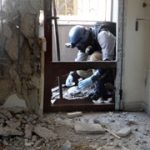Recent medical reports of chlorine gas attacks in Syria reveal a disturbing trend in the use of chemical warfare against civilians. At least 25 people reportedly suffered chemical exposure during attacks in Idlib just last week, and six people were killed – and dozens of others were wounded – in an attack on Sarmin village in March. The Organization for the Prohibition of Chemical Weapons (OPCW) confirmed gas attacks on Syrian villages back in early 2014 in their fact-finding mission report published last year. In spite of these confirmed attacks, not to mention the March 2015 UN Security Council resolution specifically condemning the use of chlorine gas as a weapon in Syria, the Syrian government continues to use weaponized gas to kill and harm civilians.
In light of these attacks, Physicians for Human Rights (PHR) released a fact sheet on chlorine gas last month. While the OPCW does not categorize chlorine as a chemical weapon per se because of its many legitimate uses, it is being dispersed in large quantities through the use of munitions in Syria – in other words, it is being used illegally as a weapon.
The OPCW characterizes chlorine gas as a choking agent, which inflicts injuries primarily to the respiratory tract. Exposure to high concentrations of chlorine gas can cause corneal burns, burning pain on exposed skin, and pulmonary edema; at certain concentrations, it can cause death within just a few minutes. Chlorine gas has a greater density than air, causing it to sink into low-lying areas such as basements and sewers. In the attack on Sarmin village, a family of six had been hiding from aerial bombardment in a basement; doctors confirmed that all six choked to death from the gas, including three children.
Chlorine gas has sometimes been deployed in Syria through the use of barrel bombs, making these indiscriminate but highly destructive explosive devices – which have had a devastating impact on Syrian cities and villages – that much more deadly. The addition of chlorine gas to these weapons has only increased the number of Syrian civilians injured and/or killed. As seen in the case of the attack on Sarmin village, civilians often hide in basements during aerial bombardments because they are the only places they can go to potentially survive barrel bombs. However, once chlorine gas is added to these bombs, civilians have virtually nowhere left to hide. Their options are either to risk dying from the blast of a barrel bomb, or to hide in a basement and risk dying from chlorine gas.
Syria’s obligations to refrain from using chemical weapons are not ambiguous. As a state party to both the Chemical Weapons Convention and the Geneva Protocol, Syria is clearly prohibited from using chemical weapons and bacteriological methods of warfare. While chlorine is also commonly used in industrial processes, Article II of the Chemical Weapons Convention clarifies that toxic chemicals that can cause “death, temporary incapacitation or permanent harm to humans or animals” can also be considered chemical weapons, “regardless of their origin or of their method of production.” Chlorine gas, as well as other toxic chemicals originally produced for non-harmful purposes, should not be appropriated as chemical weapons by any party to a conflict.
Existing evidence shows that these gas attacks are being carried out through aerial bombardment – a means only available to the Syrian government. The UN Security Council must act to stop the violation of its resolutions against the use of chemical weapons in Syria before more innocent lives are lost.

